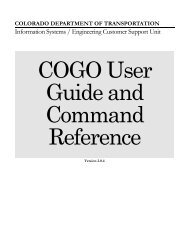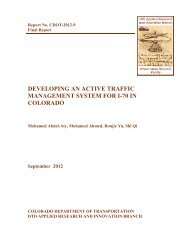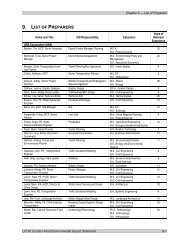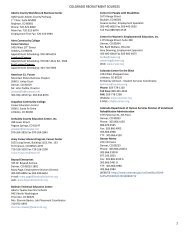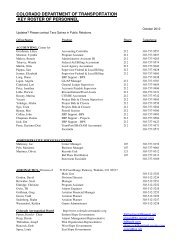Chapter 5 THE AUTOMOBILE AGE BEGINS, 1890-1930 - Colorado ...
Chapter 5 THE AUTOMOBILE AGE BEGINS, 1890-1930 - Colorado ...
Chapter 5 THE AUTOMOBILE AGE BEGINS, 1890-1930 - Colorado ...
You also want an ePaper? Increase the reach of your titles
YUMPU automatically turns print PDFs into web optimized ePapers that Google loves.
For decades, both the state and national publications extolled the natural wonders of <strong>Colorado</strong>.<br />
Inspired by a 1915 Kansas City Post article describing the Rocky Mountains as the “Playground<br />
of America,” many drivers came from across the nation to the see <strong>Colorado</strong>’s natural wonders<br />
(<strong>Colorado</strong> Highways, March 1926(b): 9). The automobile fostered tourism in its development as<br />
one of the state’s most important industries. After World War I, it was the job of the Highway<br />
Department to keep visitors coming back to <strong>Colorado</strong> through the construction of well-built and<br />
designed roads.<br />
In 1919, the Highway Commission supervised its first major post-war mountain construction<br />
project over 11,400-foot Monarch Pass. Two-thirds of the 27.5-mile long Monarch Pass<br />
Highway ran through Cochetopa National Forest. The U.S. Forest Service contributed $204,450<br />
to complete the job through the National Forest. The road was hacked out of the mountains<br />
mostly by pick and shovel and team and wagons, and the pass’s narrow and steep conditions and<br />
dangerous curves tested laborers (<strong>Colorado</strong> Highways, April 1922: 8; Jeffrey: 1922). Crews<br />
contracted to the Bureau of Public Roads completed the highway through the forest in 1922.<br />
Although it was considered an engineering triumph of the early 1920s, the completed road was<br />
difficult and dangerous. By 1938 the Highway Department cleared a new Monarch Pass route<br />
less than a mile southeast of the original route. Designed with more maneuverable curves and<br />
improved alignment, the rebuilt Monarch Pass Highway reached an altitude of 11,312 after<br />
completion in 1939 (Rocky Mountain Contractor, October 12, 1938: 6).<br />
High-country construction visited all the state’s mountain ranges during the 1920s. In the San<br />
Juan Mountains, Otto Mears’ toll road from Durango to Ouray underwent reconstruction from<br />
south of Ouray to the top of Red Mountain Pass between 1921 and 1924. The <strong>Colorado</strong><br />
Highway Department, Bureau of Public Roads and U.S. Forest Service contributed funds toward<br />
construction. During the submission of bids, one contractor spoke up after realizing the cost of<br />
building the auto highway would approach $1 million dollars. He referred to the project as “the<br />
million dollar highway that we’re building.” The phrase caught on, and at the July 1924 ribbon<br />
cutting, a sign was erected with the name “The Million Dollar Highway.” The state highway<br />
publication <strong>Colorado</strong> Highways commented in August 1924 that the Million Dollar Highway<br />
Final<br />
CDOT Historic Highway Context<br />
5-27





